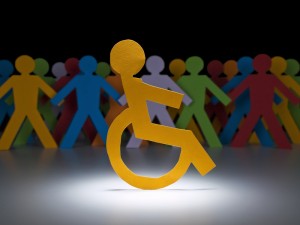
In the UK over 10 million people live with a disability, many of whom suffer from violence (Department for Working Pensions, 2011). A recent World Report on Disability by WHO (2011) highlighted that people living with disabilities are at risk from sexual and physical violence.
Despite this, little is known about who is at risk of violence, what the consequences of this violence are, and the types of violence they suffer (Hughes, 2012). This information is important for a number of reasons, not least because it could be used to increase the detection and reduction of violence. For these reasons a new study based on the British Crime Survey (BCS) has begun to address some of these questions (Khalifeh, 2013).
The researchers asked:

Are people with disabilities at greater risk of violence than those without a disability?
- Are people with disabilities at greater risk of violence than those without a disability, and do people with mental illness have a greater risk than those with other disabilities?
- Do disabled victims experience more severe health problems following violence than non-disabled victims?
- What proportion of violence victimisation in the population as a whole (and in those with disability) is attributed to the independent presence of a disability, and what are the economic costs of this?
Methods
The study analysed data collected from the 2009/2010 British crime survey (BCS). The BCS is a nationally representative cross-sectional survey of crime victimisation in men and women aged 16 or over living in private residential households in England and Wales. The survey is conducted by lay interviewees who use door to door visits to interview people, including measures of non-domestic and domestic physical and sexual violence. Sexual assaults are measured using a more sensitive questionnaire, but only on those aged between 16-60.
99.5% of BCS respondents were included in the analysis; 9,037 of people reported a disability. Disability was defined as: “A long standing physical or mental health condition that has lasted or is expected to last 12 months or more and which limits day to day activities”.
The sub-types of disabilities reported included: long-term physical illness, learning disability, mental health conditions and mobility and sensory impairments.
The researchers conducted a multivariate logistic regression. One analysis was carried out on the whole data and a separate analysis was carried out on the self-completion questionnaire on sexual violence.
Results

Disabled people were more likely to experience mental health problems following violence, especially those with pre-existing mental illness
- They found a clear association between disability and both physical and sexual assaults. With a higher risk of violence among those with mental illness that any of the other subtypes of disability
- Domestic violence was reported around 7% more in disabled versus non-disabled victims, with 8% fewer reports of non-domestic violence by disabled victims
- Those with one or more disabilities were more likely to be a victim of violence in the past year when compared with the non-disabled population
- Overall, disabled people were more likely to experience mental health problems following violence, especially those with pre-existing mental illness
Conclusions
The authors concluded:
People with disability are at increased risk of being victims of domestic and non-domestic violence, and of suffering mental ill health when victimized. The related public health and economic burden calls for an urgent assessment of the causes of this violence, and national policies on violence prevention in this vulnerable group.
The authors also note that the research highlights the need for clinicians to be aware of elevated risk violence among patients with all types of disabilities, and that clinicians should consider explicitly screening for violence and its effects. It was estimated that in England in 2009, 116,000 disabled victims may have experienced violence because they had a disability, which cost around £1.51 billion.
Whilst this is a large nationally representative sample, the authors caution that it did not include people living in residential supported accommodation and that there is possible reporting and disclosure bias because of fear of reporting, and/or because some disabilities could make filling out interviews and questionnaires difficult. This means that the findings may under-represent the experiences of violence in these groups. Nevertheless, this study is an important step forward in understanding the violence against those living with disabilities in the UK.
Links
Khalifeh H, Howard LM, Osborn D, Moran P, Johnson S. Violence against People with Disability in England and Wales: Findings from a National Cross-Sectional Survey. PLoS ONE 2013; 8(2): e55952. doi:10.1371/journal.pone.0055952
World Report on Disability. World Health Organization, 2011.
Hughes K, Bellis MA, Jones L, Wood S, Bates G, et al. Prevalence and risk of violence against adults with disabilities: a systematic review and meta-analysis of observational studies (PDF). The Lancet 2012; 379: 1621–1629.
Family Resources Survey: United Kingdom 2009–2010 (PDF). Department for Works and Pension, 2011.


@Mental_Elf thanks v much for covering!
People with disability are more likely to be victims of violence and suffer mental illness as a result http://t.co/mqRkJ5qVl7 via Mental Elf
Clinicians should consider explicitly #screening for #violence and its effects in people with #disabilities http://t.co/u2EMD9bqiL
People with disability are more likely to be victims of violence and to suffer mental illness as a result – http://t.co/DV6npWuYHd
New @PLOSONE paper improves our understanding of violence against those living with disabilities in the UK http://t.co/u2EMD9bqiL
2009 crime survey of England: 116,000 victims may have experienced violence because of their disability http://t.co/u2EMD9bqiL
RT @mental_elf: 2009 crime survey of England: 116k victims may have experienced violence because of their disability http://t.co/R4w6goWZ2j
Las personas con discapacidad son más propensas ser víctimas de la violencia y a padecer trastornos mentales por ello http://t.co/JPAOklANTD
People with disability are more likely to be victims of violence and to suffer mental illness as a result http://t.co/MmYEe3BCaD
RT @Mental_Elf: New cross sectional survey finds that domestic violence is reported more by people with disabilities http://t.co/u2EMD9bqiL
People with disability more likely to be victims of violence an to suffer mental illness as a result » The Mental Elf http://t.co/pPvzugcwQQ
RT @thefworduk: People with disability are more likely to be victims of violence and to suffer mental illness as a result » http://t.co/ …